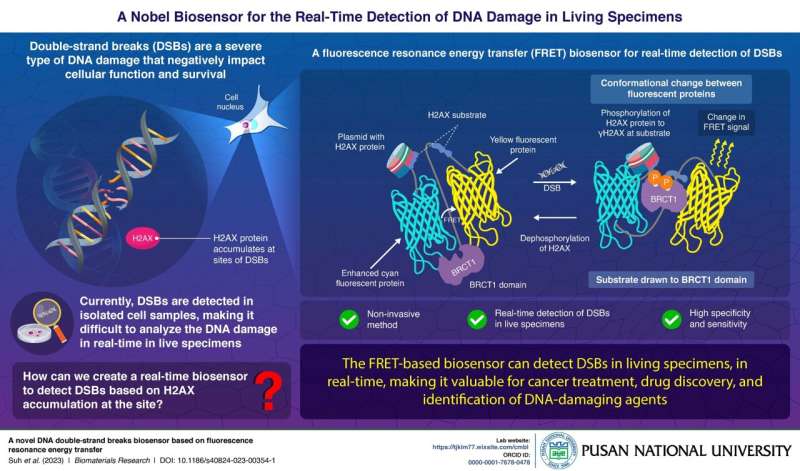A novel biosensor to detect DNA damage in real time

Double-strand breaks (DSBs) are a type of DNA damage where both strands of DNA break at the same location. They can adversely affect cell growth and functioning. Currently, DSBs are detected by immunostaining techniques, which identify markers that accompany DNA damage, such as the protein 纬H2AX. However, these methods are tedious, and cannot be used to detect DSBs in real time in living specimens.
In a 2023 study, published in Biomaterials Research, researchers describe a fluorescence resonance energy transfer (FRET) biosensor that can detect DSBs in real time, and provide time- and location-based information on yH2AX. "The biosensor we have designed could be useful in areas such as cancer treatment and drug discovery," says Associate Professor Tae-Jin Kim, from Pusan National University, Korea, who led the study.
FRET sensors consist of two fluorescent proteins or dyes鈥攁 donor and an acceptor鈥攚hich investigate interactions between biological molecules. The energy transfer, and consequently, the amount of emitted light (the FRET signal) depends on the distance and orientation between the two dyes.
The researchers attached the fluorescent dyes with proteins that are involved in the cellular response to DNA damage, namely the H2AX substrate and BRCT1 domain. The H2AX substrate is a target for the H2AX protein to bind and become phosphorylated (forming 纬H2AX).
On the other hand, the BRCT1 domain acts as a site for the accumulation of repair proteins, including 纬H2AX. Thus, when a DSB occurs, 纬H2AX is attracted to the BRCT1 domain, leading to a conformational change in the fluorescent proteins, thereby causing a change in the FRET signal.
The researchers then confirmed the validity of the sensor by introducing plasmids (DNA that, here, contain instructions to make the FRET sensor inside the cells) encoding the FRET sensor into human embryonic kidney cells (HEK293T) cells. Compared to conventional immunostaining techniques, this biosensor was more sensitive at reacting to the presence of 纬H2AX, making it more effective at detecting drug- and radiation-induced DSBs.
"Moreover, as changes in the FRET signal give useful indications of the extent of the DNA damage, the sensor can also be used to examine DNA damage and repair mechanisms, optimize cancer treatments, discover and assess DNA repair drugs, and identify DNA damaging factors in the environment," concludes Associate Prof. Kim.
More information: Jung-Soo Suh et al, A novel DNA double-strand breaks biosensor based on fluorescence resonance energy transfer, Biomaterials Research (2023).
Provided by Pusan National University

















